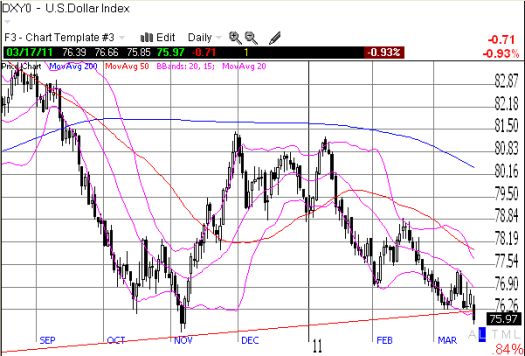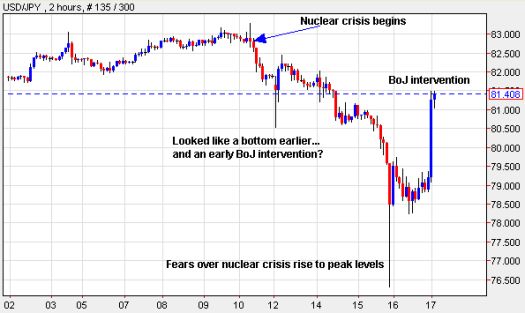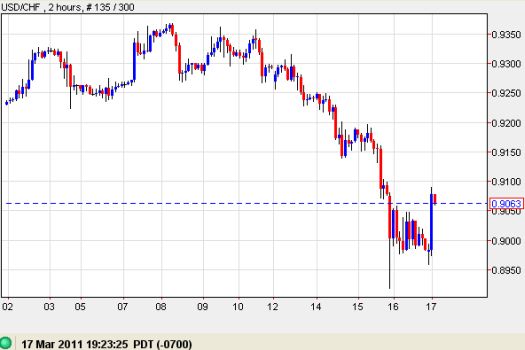NOW things get even more interesting for the U.S. dollar. In dramatic fashion, a tremendous surge in buying in the Swiss franc and the Japanese yen shortly after the close of the U.S. market on Wednesday set the dollar hurtling through its long-term support line. This break was long in the making and something I finally accepted as “inevitable” just a month ago. This move forced me to clear the deck of my positions anticipating one more bounce from support…until the announcement of a G7 meeting presumably to help the Bank of Japan weaken its currency and support liquidity in its financial markets. Given the poor recent history on interventions, I was very reluctant to bet heavily on this event, especially given news flow from Japan could have swung this against me again before I could reap the rewards of an intervention.
Here is the statement from the G7 (as posted by the ECB):
“We, the G7 Finance Ministers and central bank governors, discussed the recent dramatic events in Japan and were briefed by our Japanese colleagues on the current situation and the economic and financial response put in place by the authorities.
We express our solidarity with the Japanese people in these difficult times, our readiness to provide any needed cooperation and our confidence in the resilience of the Japanese economy and financial sector.
In response to recent movements in the exchange rate of the yen associated with the tragic events in Japan, and at the request of the Japanese authorities, the authorities of the United States, the United Kingdom, Canada, and the European Central Bank will join with Japan, on 18 March 2011, in concerted intervention in exchange markets. As we have long stated, excess volatility and disorderly movements in exchange rates have adverse implications for economic and financial stability. We will monitor exchange markets closely and will cooperate as appropriate.”
So far, the Bank of Japan (BoJ) is getting its wish as the yen returns close to pre-crisis levels against most major currencies. The big difference this time around is that the intervention is coordinated, whereas the BoJ’s last intervention(s?) was unilateral. The intervention in September saved the dollar from following through on a breakdown below its 200-day moving average (DMA) – a bounce that was very short-lived. This time, the uncertainty is even greater given poor news flow could erase all the hard work of the coordination in a flash, at least assuming the market’s stubborn desire to keep buying yen no matter the backdrop continues unabated.
For now, I am assuming that once the dust settles the dollar will resume its weakness against most major currencies, excluding the yen, but also that the yen will tend to weaken even more absent supportive news flow that scares buyers back into action.
Here is the statement from the Bank of Japan, emphasis mine:
“The Bank of Japan strongly expects that Japan’s concerted action with G7 member countries in the foreign exchange market will contribute to the stable formation of foreign exchange rates.
The Bank of Japan will pursue powerful monetary easing and, to ensure stability in financial markets, will continue to provide ample liquidity.”
The wordsmiths were working overtime. The BoJ clearly wants to fire as strong a warning as possible to those who insist on buying yen. Choosing the adjective “powerful” to describe a monetary action is just one inspired moment short of “shocking and awesome” monetary easing.
The following charts describe the action better than words. The plunge and the surge are equally dramatic in both scale and speed.
First, a chart of the dollar index BEFORE the intervention. The red diagonal line streaking across the bottom is the line of support that connects back to the 2008 bottom. (Click here for the longer-term chart).

*Chart created using TeleChart:

This 2-hour chart shows the dramatic swings in the USD/JPY currency pair since the earthquake in Japan. Yesterday’s plunge had already reversed itself by the time of the intervention, but the intervention has not returned the dollar to pre-crisis levels against the yen. The intervention has also accomplished a significant post-crisis reversal for other yen currency pairs. (See “The Story Behind the Yen’s Record Surge” for the WSJ’s fascinating account of the yen’s rapid rise which apparently was the 5th largest ever for USD/JPY).

Source: dailyfx.com charts
The purchase of dollars to effect the yen intervention caused the dollar to appreciate against some major currencies. This effect has already largely warn off except with the franc. The dollar has now recovered its losses from yesterday, but it is far from a post-crisis recovery.

Source: dailyfx.com charts
Speaking of the franc, the Swiss National Bank (SNB) finds itself stuck in a very tight spot: the franc has already appreciated well beyond the bank’s comfort level. Although overall economic activity has not suffered too much, the SNB did point out in this morning’s monetary policy statement that tourism has declined and export growth has slowed due to the franc’s strength. This statement did not conclude with another ominous warning that the SNB will defend the weakness of its currency. Instead, the SNB reminded the market that given the high inflation forecast toward 2013, the current expansionary monetary policy must come to an end some time before then. (Click here for a brief summary and description on the Swiss National Bank’s announcement on monetary policy.)
The dollar’s breakdown did not generate much interest in silver or gold, but there could be renewed interest with more and more yen coming to town.
Be careful out there!
Full disclosure: long USD/JPY (positioning for net short dollar, net short yen); long GG, PAAS, SLV

“shocking and awesome”
Oh, Duru, you have made my day! LOL! Sheer poetry! And to satirize that infamous spinmeister while dis[cuss]ing the jaw-boning of central bankers: priceless!
Glad you enjoyed it! 🙂